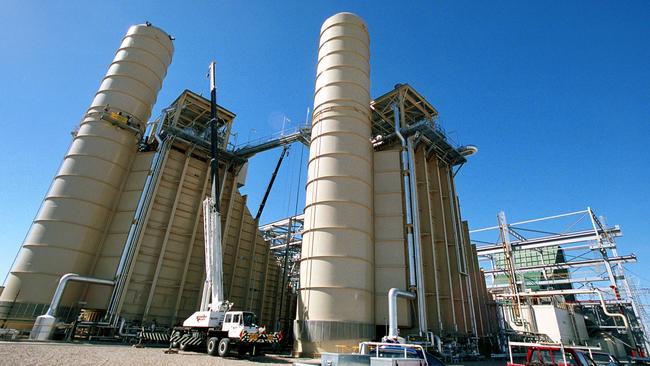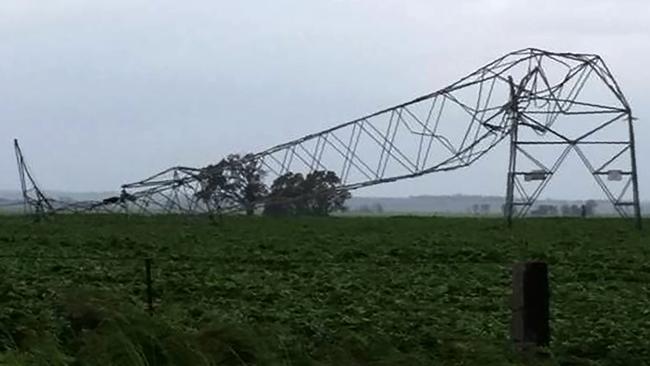8 options to fix South Australia’s unreliable electricity system
THE state’s been hit by three blackouts this year, including a statewide one in September. How can we fix our unreliable power supply? Here are eight options.
- Analysis: Jay’s pie-in-the-sky carbon folly
- Back-up gas plant may zap unstable power supply
- Turnbull and Weatherill in war of words over carbon pricing
- The Energy Intensity Scheme explained
- Prime Minister rules out carbon pricing after backbench revolt
SOUTH Australia has been hit by three major power blackouts this year, including one in September that shut down the entire state.
Political leaders on Friday will consider plans to improve energy security and make power more affordable.
Chief Reporter Paul Starick examines options to boost the state’s grid.
-----------------------------------
High-voltage interconnector from New South Wales.
The State Government’s favoured option to import, ironically, cheap coal-generated power. Estimated to cost about $500 million, which Treasurer Tom Koutsantonis has argued represents good value for a potential public contribution to the cost to safeguard supply.
SA has just one major interconnector, with Victoria, that has shut down twice in the past three months, triggering blackouts of the whole state in September and, this month, 200,000 homes and businesses.
Separate high-voltage links with the nation’s two biggest states would all-but guarantee supply, even if there are some concerns about the cost.
Ramp up Pelican Point power station
Opened in November, 2000, gas-fired Pelican Point was mothballed in mid-2014 and only returned to half capacity in the wake of July’s electricity supply crisis, when the state’s largest industrial users were on the brink of shutdown.
The 478MW station now has 239MW available to the national electricity market — the rest is mothballed. But it is not profitable for Pelican Point to operate every day. This is because the spot price of electricity on the national market must be at about $60 per megawatt hour for the plant to just break even.
On a windy morning late yesterday, the spot price was $21 MW/H and, therefore, Pelican Point was not operating.
Pelican Point’s operations since July have been underpinned by a contract with BHP and there is a possibility of it winning a State Government tender to supply 75 per cent of its long-term energy needs.
Restarting Pelican Point has been hailed by Premier Jay Weatherill as a measure to drive down prices and boost security.
Operating at full capacity, it offers a potential solution to baseload power issues and could drive down prices, depending on the response of gas-fired rival Torrens Island, operated by AGL.

Emissions intensity scheme
Premier Jay Weatherill argues this carbon scheme can lower prices and improve security in South Australia. He is backed by some electricity industry figures and fiercely opposed by others.
An emissions intensity scheme penalises electricity generators who emit carbon above a set limit. Cleaner generators who pollute below this limit do not pay and can trade free credits.
It is expected to be recommended by chief scientist Alan Finkel, arguing that it is the best way for Australia to move away from dirty coal-fired generators to gas and renewables.
But some industry figures argue it will worsen SA’s woes by increasing the subsidy to renewables, further undermining Pelican Point and Torrens Island. They argue this is a major reason why Port Augusta’s coal-fired power station closed in May.
Battery storage
AGL yesterday revealed it could have a fast-action gas plant and battery storage operating at Torrens Island within two years. This would ramp up within minutes to meet changes in supply and demand, by enabling power to be stored in batteries and released quickly while firing up the gas plant.
AGL in August launched a “virtual power plant”, in which 1000 connected batteries in SA homes and businesses will provide 5MW capacity at peak times. It offers consumers the ability to store energy from rooftop solar systems.
Fuelled by interest in Tesla’s Powerwall, battery storage is becoming increasingly popular but remains out of the price reach of many homeowners.
It is expected to grow increasingly popular but critics warn it will not replace baseload power, particularly for industry, and is not a swift answer to SA’s power woes.
Reform national electricity market
The Council of Australian Governments energy council in August agreed to significant reforms aimed at ensuring the system was affordable and reliable. These focused on increasing liquidity and transparency in the gas markets, measures to enable consumers to take advantage of technologies like battery storage and a review of regulations about interconnectors.
The latter is designed to ensure red tape does not stop investment in high-voltage interstate connections, like that proposed for SA and NSW.
But there is some argument these reforms are merely tinkering at the edges. Critics argue the national market now unduly rewards, through subsidy, excessive construction of wind farms and solar arrays, rather than focusing on the need for a secure electricity system while also reducing emissions to meet international obligations.

Renewables
South Australia has one of the highest adoption rates of renewable energy, which is about 41 per cent of the state’s generation capacity. Mostly, this comes from wind farms but also from rooftop solar.
Premier Jay Weatherill argues stronger links to the national market, through an interconnector, will allow SA to increase its supply of wind and solar power and sell it into the national grid. This has had some support from NSW.
But renewables are intermittent — they rely on wind and sun. Critics argue this has dangerously exposed SA to an energy supply crisis and pushed up electricity prices to the nation’s highest.
Reopen Port Augusta
Brisbane-based power investor Trevor St Baker was planning to reopen the coal-fired plant, closed in May. Just last weekend, he said all that was standing in the way was the reluctance of BHP Billiton to sign a purchase agreement. But The Advertiser this week revealed BHP had done a deal in July with Pelican Point for supply, underpinning that plant’s partial reopening.
When Port Augusta’s closure was announced last year, industry experts repeatedly warned of more blackouts and increased prices as substantial baseload power was withdrawn. A partial reopening, now highly unlikely, might ease these.
Nuclear power
Nuclear has been discussed for years in Australia but dismissed as uneconomic. The latest finding was in the Nuclear Fuel Cycle Royal Commission, which released its final report in May. Smaller, next-generation nuclear plants now in development offer significant potential to supply SA and other states but regulatory hurdles and public scepticism — in many cases hostility — would first have to be overcome.
The Royal Commission found nuclear power was a potentially distant prospect.
